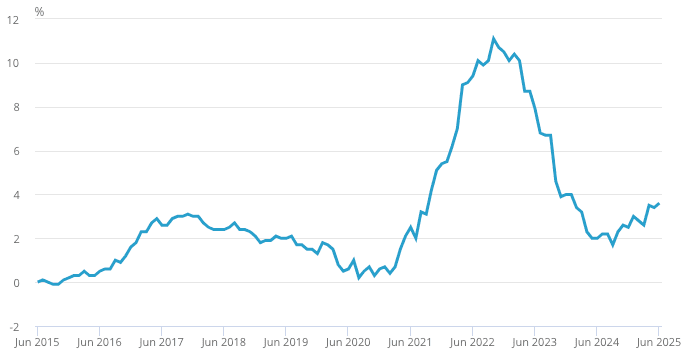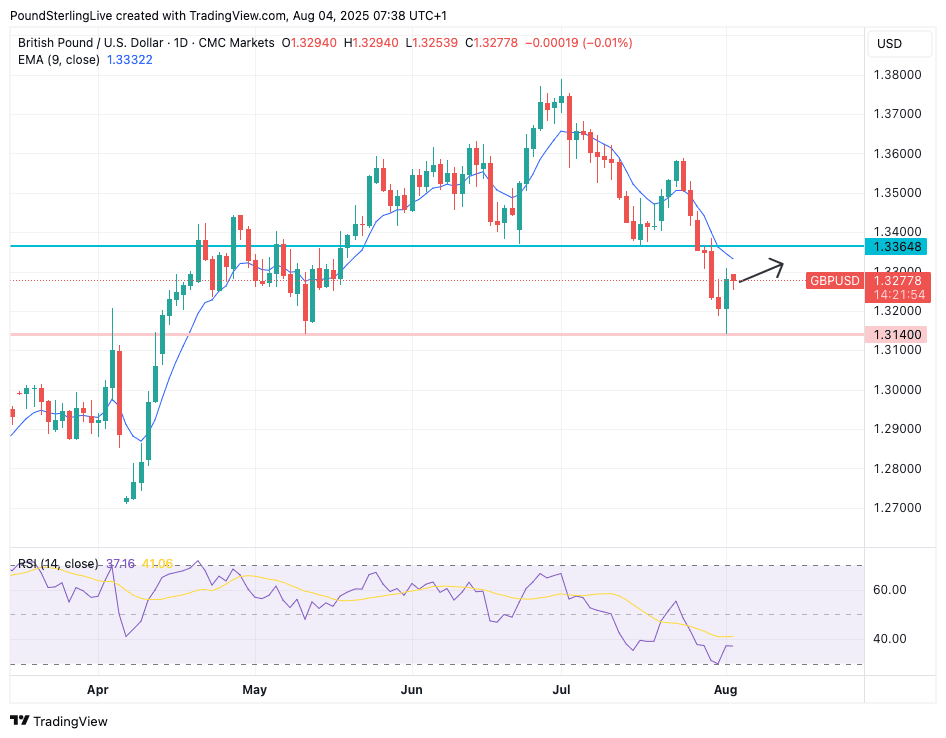
Image © Adobe Images
The sharp reversal on Friday steadies the Pound's outlook against the Dollar.
The Pound to Dollar exchange rate (GBP/USD) rebounded on Friday to steady a rapidly sinking ship and potentially even refloat it.
A run of six consecutive daily declines took GBP/USD to as low as 1.3140 on Friday, before a significant jump pulled it back to 1.3282.
By this stage, a bounce was increasingly likely owing to the oversold nature of GBP/USD that left it ripe for any excuse to correct higher. That excuse was forthcoming in Friday's U.S. job report which was surprisingly weak, with the headline non-farm payroll printing at 73K, well below the consensus estimate of 110K.
Markets raised the odds of a September interest rate cut at the Federal Reserve in the data's wake, judging that the Fed would have to look through uncomfortable inflation trends and offer the economy some support via lower interest rates.
The reappraisal led to lower U.S. short-term bond yields and inevitably weighed on the Dollar. Readers looking to capitalise on potential GBP/USD gains should consult our latest investment bank forecast survey, available via a free download, as it provides updated 3, 6, 9, and 12-month projections from 30 major investment banks. It offers a useful reference point for anyone considering timing a currency transfer.
From a near-term technical perspective, GBP/USD's recovery can extend in the near term as it tries to mean-revert to the nine-day exponential moving average currently at 1.3333. We would not be surprised to see the recovery extend a little beyond here, and that puts the graphical resistance line at 1.3364 in scope for the coming days.
Should the exchange rate rise above the nine-day EMA then the short-term trend will have flipped from lower to higher. So there is still some technical work to be done before we can truly call the end of the recent spell of weakness.
Fundamentals could support that technical recovery in GBP/USD that we are looking for: The Dollar fell on Friday alongside U.S. stock markets, suggesting investors are wary that the U.S. exceptionalism story is finally fading as the economy succumbs to Donald Trump's frantic first six months in office that has seen significant development and international policy shifts.
Tariffs are likely to push up domestic prices, which complicates the Federal Reserve's ability to cut interest rates. If the Fed isn't there to provide a backstop to markets as has been the case since 2008, then investors could get very nervous and continue selling.
Under such a scenario, the Dollar could come under notable pressure.
For now, we think panic will be avoided, but it's a scenario we're increasingly wary of.
Domestically, it is the Bank of England that will capture FX market attention this week as it is set to cut interest rates by 25 basis points.
The cut would be a curious one to anyone who has looked at UK inflation figures lately and noted the steady trend higher in the price level. Add to this surging food prices, and one might ask what the Bank is playing at.

Above: UK inflation is rising again.
For its part, the Bank will justify the rate cut on the slowing economy and its perpetual belief that inflation will drop to 2.0% at some point in the coming year. It is this optimism in its inflation forecast that has allowed it to cut interest rates as much as it has.
If the Bank chooses to look through inflation trends and warn further cuts are needed to protect the jobs market, then the Pound can come under pressure.
However, should the Bank reflect more on its mandate to bring inflation down to 2.0% and concede its forecasts are sketchy at best, then it might warn against any guaranteed future cuts.
This would represent a 'hawkish' cut, which would be the most supportive outcome for the Pound. Were it to materialise, the GBP/USD could test 1.3360-1.34 ahead of the weekend.

